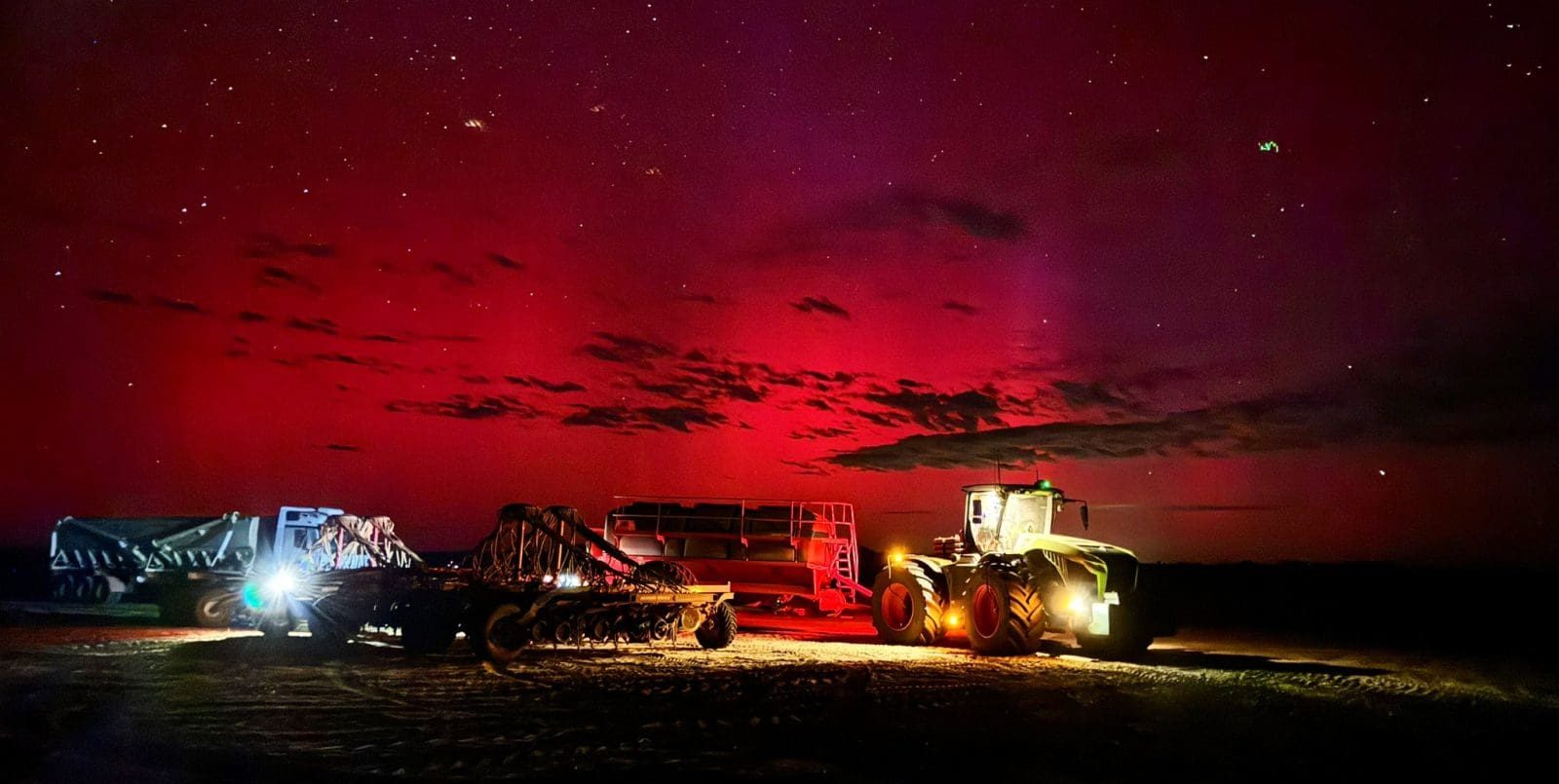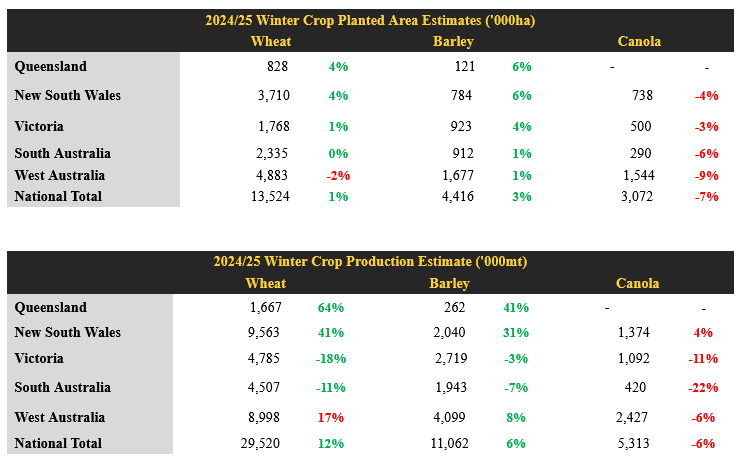
Many growers across Australia have enjoyed a rare northern display from the Aurora Australis during sowing 2024. Photo: Amery Drage, Northampton, WA
AUSTRALIA has now entered its main planting period for wheat and barley, and around 25mm of rain is desperately needed in most districts to allow all intended area to be planted.
It will also shore up prospects for pulses, canola and cereals already in the ground across southern Australia, and for wheat yet to be planted in Central Queensland.
The national crop is generally seen at 65pc planted, with the swing from early-planted canola to later-planted chickpeas slowing progress a little.
Of all the crops, chickpeas have the brightest production prospects this season, based on good subsoil moisture profiles in the key production areas of Qld and northern New South Wales.
Further buoying prospects for chickpeas is this month’s news that India has removed tariffs on the pulse, and only availability of seed for planting will limit Australian area.
Across southern Australia and into central NSW, growers ideally like to have all winter crop planted by early June.
While much of the crop in Western Australia, South Australia and Victoria has been planted, a lack of rain on dry-sown areas means few crops have germinated so far, and growers are anxiously watching the forecast in the hope that widespread rain falls in the next three weeks.
Ahead of ABARES release next month of its state-by-state new-crop area and production estimates, some private forecasters have released their initial figures for the crop now being planted.
Among them is Australian Crop Forecasters.
“WA is at around 60pc planted, and will keep dry seeding until they reach around 80pc before stopping to wait for rain,” ACF senior insights manager James Maxwell said.
“Canola area is going to be cut back, along with potential cuts to lupin area.
“Some in Esperance have finished, and have planted their full programs dry for the first time ever.”
Mr Maxwell said SA’s situation was very similar to WA’s, both in sowing and potential changes in planted area.
In Vic, ACF puts the crop at up to 75pc planted in the Mallee, 50-60pc sown through the Wimmera, and less than 50pc sown in the mixed-farming Western District region.
“NSW is 60-70pc planted overall, with some growers through the central region 80-90pc done due to their early start and good seeding conditions.
“In Queensland, wheat is around 30-40pc planted, and that will really ramp up over the next couple of weeks.”

Australian Crop Forecasters’ current area and production estimates for Australia’s three major winter crops.
Following is a round-up of conditions by state:
Queensland
In Central Qld, Nutrien Ag Springsure agronomist Darren Young said planting is in full swing.
“We’re on chickpeas at the moment, as we haven’t got a lot of moisture to plant wheat,” Mr Young said.
While chickpeas are being planted at depth into subsoil moisture, Mr Young said many growers were looking for 25mm of rain to wet the topsoil and allow intended wheat area to be planted.
CQ’s chickpea area has held reasonably steady in recent years, and Mr Young said it has some upside if topsoil stays dry, and if sufficient seed is available to allow chickpeas to crib some wheat area.
He said most growers had retained chickpea seed from last year, but those that had not were finding parcels hard to obtain.
“Getting seed is hard work.”
Mr Young said growers will plant wheat well into June, or possibly even early July, while chickpea planting is expected to finish well ahead of that.
On the Darling Downs of southern Queensland, Nutrien Ag agronomist Hugh Reardon-Smith said oat crops are established, and some paddocks have been sown to barley and long-season wheat.
“It’s a bit early for us; winter planting won’t really kick in until June, as we’re a bit cautious about going too early and frost risk,” Mr Reardon-Smith said.
An increased chickpea area is expected to be planted, but only as much as the limited amount of seed available allows.
“The shortage of seed will limit area.”
New South Wales
Boolah Farms’ Gunnedah-based chief executive officer Sam Conway said the operation’s winter-crop planting was around 35-40pc complete.
“It’s been stop and start with the showery weather,” Mr Conway said.
“We kicked off on Anzac Day, and we’ve lost eight or nine days with wet weather; it’s been pretty challenging, but it looks like a dry run now, and in two weeks, we should be done.”
Boolah is one of a number of growers in northern NSW that will be growing chickpeas instead of canola as their rotation crop.
“Our chickpeas will be going in in the last week or so of May.”
Across northern NSW, soil-moisture levels are ideal for chickpeas, and many growers have retained sufficient good-quality seed to plant a big crop.
In central and southern NSW, where canola will remain the key crop to rotate with cereals, growers are generally two-thirds planted at the ideal time, and in favourable conditions.
Victoria
Victorian growers are anywhere from halfway through planting to nearly finished.
At Rupanyup in the Wimmera, Nutrien Ag agronomist Brad Jackson said outside of a band of storm rain last week that caught some paddocks between roughly Lubeck and Warracknabeal, topsoil is dry.
However, growers are pressing on with planting.
“Another good solid week…will mean we’ll have all the crop in dry, which is making guys a little bit nervous,” Mr Jackson said, adding that opening rain for the Rupanyup district generally arrives by May 25.
“In the past couple of years, we’ve had an early break.
“It is unusual to have a fair whack of the crop in dry.
“We’re pretty comfortable, but we’d like to see an opening rain soon.”
Mr Jackson said little emergence has been seen so far, apart from pockets of canola sown early into wet topsoil, and “the odd bean poking through”.
While faba beans, lentils and canola are generally in the ground, many growers still have considerable area left to sow with wheat and barley.
Sparke Agricultural and Associates principal Matthew Sparke is based at Horsham, and estimates growers are around half to two-thirds through their sowing program, despite topsoil being dry.
“Nobody’s stopped; we’ve got a lot of moisture underneath,” Mr Sparke said.
Mr Sparke said canola area may drop back as the weeks roll into the cereal-planting window, and that growers will have their work cut out for them once the break comes and weeds as well as crops germinate.
“We may have a few herbicide problems; we’ve had very few knockdowns, and the pressure on pre-emergents is big.”
Tasmania
In Tasmania’s grain-growing areas, conditions are mostly dry, and much intended area is yet to be planted.
XLD Commodities general manager John Tuskin said if mild weather continues, growers can look at planting into mid-June.
“They’re holding out for moisture, and it’s not like other years, when they’ll say ‘we’ve got to get it in before it gets too cold’,” Mr Tuskin said.
Some canola is being planted, but many growers are yet to make a start on winter wheat and barley.
Indications are that Tasmania will grow 9000ha of poppies for Extractas Bioscience to supply the pharmaceutical industry, up from 3000ha last year.
Mr Tuskin said this was likely to impact on area planted to spring barley.
South Australia
Dry sowing is advancing at pace in SA as growers look to get cereals as well as canola, lentils and faba beans into the ground in time to catch the season’s opening rain.
Elders’ YP AG Kadina-based agronomist James Easter said crops are being planted on top of good subsoil moisture, and forecasts were not throwing up chances of a widespread break until June.
“Everything’s quite dry; we’ve had no real rain since February,” Mr Easter said.
“We do have lentils sitting in the ground, because they can sit for ages, and a lot of mouse bait on top.
“There’s a little bit of canola in, but growers are holding back a bit on the cereals.
“Each day is a day closer to when the season break does come.”
Western Australia
Most growers are two-thirds or more planted, and much of the state’s growing areas beyond the Albany Zone are hanging out for rain to germinate canola, lupin and cereal crops.
Pioneer Seeds Central Wheatbelt farm services consultant Rob Bagley said some crops have had a patchy germination after light falls, but are turning blue, and desperately in need of soaking rain to underpin their chances of survival.
“We’ve finished sowing dry, and now we’re kneeling at the altar and praying for rain,” Mr Bagley said.
“Timing is getting a bit late, but if the rain comes in June, it could turn things around into a good season.”
The WA situation was outlined in detail in the Grain Industry Association of WA May crop report released on Friday.
Grain Central: Get our free news straight to your inbox – Click here

HAVE YOUR SAY